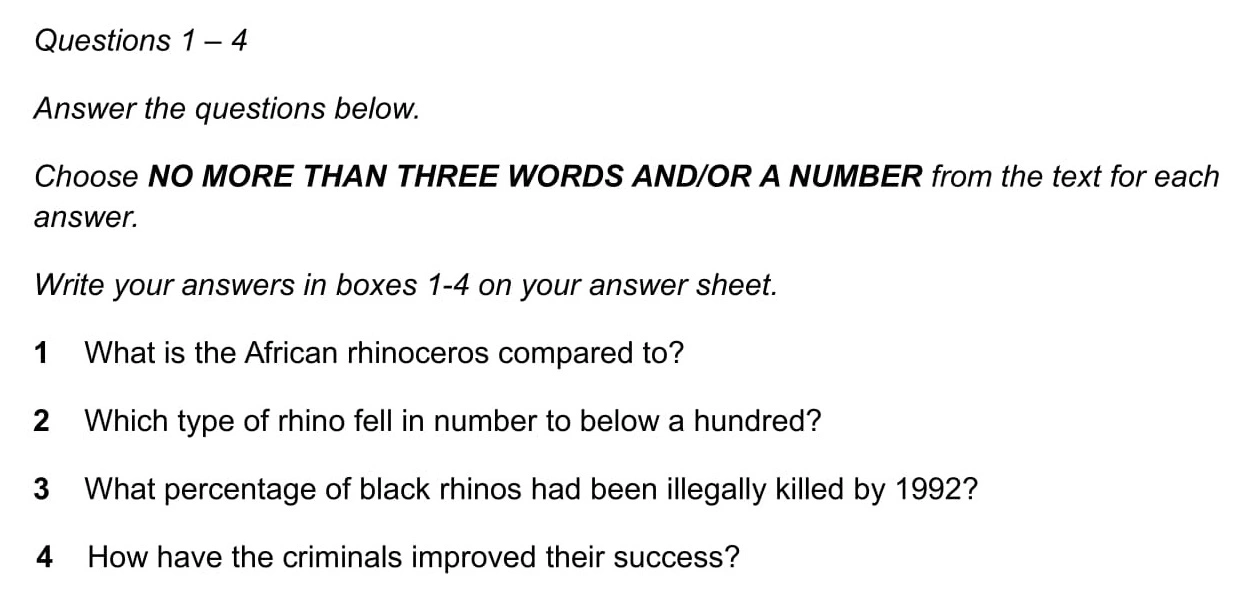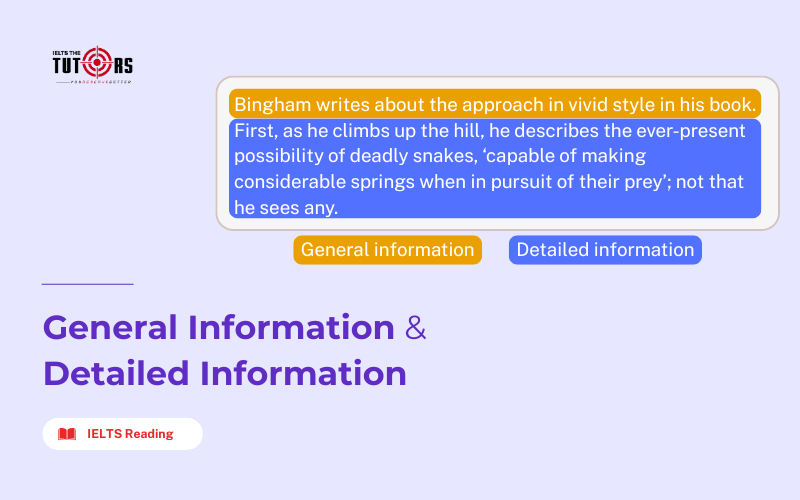
Short Answer Questions là một trong những dạng bài phổ biến và đóng vai trò quan trọng trong phần thi IELTS Reading. Để đạt điểm cao ở dạng bài này, bạn cần hiểu rõ chiến lược làm bài, tuân thủ quy tắc đề bài, và đặc biệt chú ý đến sự cẩn thận trong quá trình trả lời. Bài viết dưới đây sẽ mang đến cái nhìn tổng quan về dạng bài Short Answer Questions, các chiến thuật hiệu quả và những bí quyết vàng giúp bạn tự tin chinh phục điểm số cao nhất. Hãy cùng khám phá ngay nhé!
| Key takeaways |
| Short Answer Questions yêu cầu thí sinh trả lời câu hỏi bằng các từ hoặc cụm từ được lấy trực tiếp từ bài đọc.
Các bước làm bài:
Mẹo làm bài ăn điểm:
|
Tổng quan dạng bài Short Answer Questions IELTS Reading
Short Answer Questions yêu cầu thí sinh trả lời câu hỏi bằng các từ hoặc cụm từ được lấy trực tiếp từ bài đọc, đồng thời phải tuân thủ giới hạn số từ theo quy định của đề bài. Đặc điểm này khiến dạng bài có nét tương đồng với các câu hỏi điền vào chỗ trống.
Dưới đây format đề thi Short Answer Questions IELTS Reading:

Các bước làm Short Answer Questions IELTS Reading ăn điểm

Bước 1: Đọc kỹ yêu cầu đề bài
Xác định giới hạn về số từ hoặc số được điền:
- “ONE WORD ONLY”: Điền duy nhất 1 từ. Ví dụ, nếu bạn viết “an apple” (2 từ), đáp án sẽ sai.
- “NO MORE THAN THREE WORDS AND/OR A NUMBER”: Bạn có thể dùng tối đa 3 từ hoặc 1 số. Ví dụ, “25 October” được tính là 2 từ.
Để ý cụm từ “From the passage”, nghĩa là bạn phải lấy từ vựng y nguyên từ bài đọc, không được paraphrase. Nếu không có cụm này, bạn có thể dùng từ đồng nghĩa miễn ý nghĩa đúng.
Bước 2: Đọc kỹ câu hỏi và gạch chân từ khóa
Khi đọc câu hỏi, bạn cần hiểu rõ ý nghĩa và xác định các từ khóa (keywords), từ đó dự đoán loại thông tin mà câu hỏi yêu cầu. Điều này sẽ giúp bạn định hướng tìm kiếm thông tin trong bài đọc một cách hiệu quả hơn. Có 2 loại từ khóa mà bạn cần quan tâm:
- Unchangeable Keywords: Các từ không biến đổi như tên riêng, số liệu, ngày tháng.
- Changeable Keywords: Các từ có thể bị paraphrase như động từ, tính từ, danh từ.
Ví dụ câu hỏi: Which material was primarily used for building stepwells?
- Từ khóa: “material” (chất liệu), “building stepwells” (xây dựng giếng bậc thang).
- Phân tích: Bạn cần tìm đoạn văn mô tả chất liệu chính để xây dựng stepwells.
Bước 3: Skimming để tìm ý chính của đoạn văn
Hãy áp dụng kỹ năng đọc lướt (Skimming) để nhanh chóng nắm bắt thông tin tổng thể của bài đọc và ý chính của từng đoạn. Đặc biệt, bạn nên tập trung vào câu đầu tiên của mỗi đoạn văn, thường được gọi là câu chủ đề (topic sentence), để xác định nội dung chính mà đoạn văn đề cập.
Ví dụ bài đọc: “Stepwells were primarily constructed using stone and occasionally brick to ensure durability in harsh climates.”
- Câu chủ đề: “Stepwells were primarily constructed using stone…”
Bước 4: Tìm đoạn văn chứa đáp án
Sau khi đã đọc lướt qua toàn bộ bài đọc, hãy đọc lại các câu hỏi một lần để nắm lại các từ khóa đã gạch chân, sau đó đối chiếu với bài đọc để tìm ra câu trả lời.
Lưu ý rằng thứ tự các câu hỏi trong Short Answer Questions sẽ được sắp xếp theo thứ tự xuất hiện của các thông tin trong bài đọc. Do đó, nếu bạn tìm thấy thông tin trả lời cho câu hỏi số 2 trước câu hỏi số 1, hãy quay lại đoạn văn trước đó để chắc chắn rằng bạn không bỏ sót thông tin cần thiết để trả lời câu hỏi đầu tiên.
Ví dụ: Nếu câu hỏi trước đó liên quan đến “mục đích xây dựng stepwells,” đáp án cho câu hỏi tiếp theo sẽ nằm ở đoạn kế tiếp.
Xem thêm: Hướng dẫn cách làm dạng bài Choosing A Title IELTS Reading
Bước 5: Xác định đáp án và kiểm tra lại
Sau khi hoàn thành bài, hãy kiểm tra lại đáp án của bạn:
- Đảm bảo đáp án chính xác với yêu cầu (giới hạn từ).
- Kiểm tra chính tả và ngữ pháp.
Ví dụ câu trả lời:
Câu hỏi: Which material was primarily used for building stepwells?
→ Đáp án từ bài đọc: “stone” (1 từ, đúng yêu cầu “ONE WORD ONLY”).
Chú ý chính tả: Nếu câu hỏi hỏi về “loại vật liệu”, đáp án “stone” đúng, nhưng nếu viết “stones” có thể bị sai.
Một số tips làm dạng bài Short Answer Questions
Các lỗi thường mắc khi làm Short Answer Questions
- Không xác định đúng đoạn văn chứa đáp án: Thí sinh dễ bị cuốn vào việc tìm từ khóa giống hệt trong câu hỏi mà bỏ qua khả năng thông tin đã được paraphrase.
- Không xác định đúng từ cần điền: Cần chú ý xác định rõ đối tượng thông tin cần điền (thời gian, tên, đặc điểm, v.v.) thông qua từ để hỏi (WH-).
- Không kiểm tra paraphrase của thông tin: Sau khi xác định được câu chứa đáp án, bạn cần xem xét cách thông tin đã được paraphrase để xác định chính xác đối tượng.
- Không viết đúng giới hạn số từ quy định: Nếu vượt quá số từ quy định trong bài (ví dụ: 4 từ thay vì 3), câu trả lời sẽ không được tính điểm.
- Không chọn từ có trong bài đọc: Cần sử dụng chính xác từ trong bài đọc để trả lời câu hỏi, vì từ đồng nghĩa không được chấp nhận.
Các mẹo làm dạng bài Short Answer Questions hay
- Câu trả lời phải được sắp xếp theo đúng thứ tự thông tin xuất hiện trong bài đọc.
- Trước tiên, hãy đọc kỹ câu hỏi để hiểu rõ yêu cầu, sau đó đọc đoạn văn và tìm kiếm câu trả lời tương ứng.
- Bạn cần bám sát thông tin có trong bài đọc và không được đưa ra câu trả lời dựa trên ý kiến cá nhân.
Bài tập vận dụng
The Culture of Chimpanzees
Humankind's nearest relative is even doser than we thought: chimpanzees display remarkable behaviours that can only be described as social customs passed on from generation to generation.
A. Researchers have studied the similarities between chimpanzees and humans for years, but in the past decade they have determined that these resemblances run much deeper than anyone first thought. For instance, the nut cracking observed in the Tai Forest is far from a simple chimpanzee behaviour; rather it is a singular adaptation found only in that particular part of Africa and a trait that biologists consider to be an expression of chimpanzee culture. Scientists frequently use the term “culture” to describe elementary animal behaviours, but as it turns out, the rich and varied cultural traditions found among chimpanzees are second in complexity only to human traditions.
B. During the past two years, an unprecedented scientific collaboration, involving every major research group studying chimpanzees, has documented a multitude of distinct cultural patterns extending across Africa, in actions ranging from the animals' use of tools to their forms of communications and social customs. This emerging picture of chimpanzees not only affects how we think of these amazing creatures but also alters human beings' conception of our own uniqueness and hints at ancient foundations for extraordinary capacity for culture.
C. Homo sapiens and Pan troglodytes have coexisted for hundreds of millennia and share more than 98 percent of their genetic material, yet only 40 years ago we still knew next to nothing about chimpanzee behaviour in the wild. That began to change in the 1960s, when Toshisada Nishida of Kyoto University in Japan and Jane Goodall began their studies of wild chimpanzees at two field sites in Tanzania. Goodall's research station at Gombe-the first of its kind-is more famous.
D. In these initial studies, as the chimpanzees became accustomed to close observation, the remarkable discoveries began. Researchers witnessed a range of unexpected behaviours, including fashioning and using tools, hunting, meat eating, food sharing and lethal fights between members of neighbouring communities. In the years that followed, other primatologists set up camp elsewhere, and, despite all the financial, political and logistical problems that can beset African fieldwork, several of these out-posts became truly long-term projects. As a result, we live in an unprecedented time, when an intimate and comprehensive scientific record of chimpanzees' lives at last exists not just for one but for several communities spread across Africa.
E. As early as 1973, Goodall recorded 13 forms of tool use as well as eight social activities that appeared to differ between the Gombe chimpanzees and chimpanzee populations elsewhere. She ventured that some variations had what she termed a cultural origin. But what exactly did Goodall mean by “culture”? The diversity of human cultures extends from technological variations to marriage rituals, from culinary habits to myths and legends. Animals do not have myths and legends, of course. But they do have the capacity to pass on behavioural traits from generation to generation, not through their genes but by learning. For biologists, this is the fundamental criterion for a cultural trait: it must be something that can be learned by observing the established skills of others and thus passed on to future generations.
F. What of the implications for chimpanzees themselves? We must highlight the tragic loss of chimpanzees, whose populations are being decimated just when we are at last coming to appreciate these astonishing animals more completely. The bushmeat trade is particularly alarming: logging has driven roadways into the forests that are now used to ship wild-animal meat- including chimpanzee meat- to consumers as far afield as Europe. Such destruction threatens not only the animals themselves but also a host of fascinatingly different ape cultures.
G. Perhaps the cultural richness of the ape may yet help in its salvation, however. Some conservation efforts have already altered the attitudes of some local people. A few organizations have begun to show videotapes illustrating the cognitive prowess of chimpanzees. One Zairian viewer was heard to exclaim, “Ah, this ape is so like me, I can no longer eat him.”
H. How an international team of chimpanzee experts conducted the most comprehensive survey of the animals ever attempted? Scientists have been investigating chimpanzee culture for several decades, but too often their studies have contained a crucial flaw. Most attempts to document cultural diversity among chimpanzees have relied solely on officially published accounts of the behaviours recorded at each research site. But this approach probably overlooks a good deal of cultural variation for three reasons.
I. Firstly, scientists typically don't publish an extensive list of all the activities they do not see at a particular location. Yet this is exactly what we need to know- which behaviours were and were not observed at each site. Second, many reports describe chimpanzee behaviours without saying how common they are; without this information, we can't determine whether a particular action was a once-in-a- lifetime aberration or a routine event that should be considered part of the animals' culture. Finally, researchers' descriptions of potentially significant chimpanzee behaviour frequently lack sufficient detail, making it difficult for scientists working at other spots to record the presence or absence of the activities.
J. To remedy these problems, the two of us decided to take a new approach. We asked field researchers at each site for a list of all the behaviours they suspected were local traditions. With this information in hand, we pulled together a comprehensive list of 65 candidates for cultural behaviours.
K. Then we distributed our list to the team leaders at each site. In consultation with their colleagues, they classified each behaviour in terms of its occurrence or absence in the chimpanzee community studied. The key categories were customary behaviour, habitual, present, absent, and unknown. We should note, however, that certain cultural traits are no doubt passed on by a combination of imitation and simpler kinds of social learning. Either way, learning from elders is crucial to growing up as a competent wild chimpanzee.
Questions 23 – 26
Answer the questions below.
Choose NO MORE THAN THREE WORDS AND / OR A NUMBER from passage for each answer. Write your answers in boxes 23-26 on your answer sheet.
23. When did the unexpected discoveries of chimpanzee behaviour start?
………………………………….
24. Which country is the research site of Toshisada Nishida and Jane Goodall?
………………………………….
25. What did the chimpanzees have to get used to in the initial study?
………………………………….
26. What term did Jane Goodall use in 1973 to explain groups of chimpanzees using tools differently?
………………………………….
Key answers and explanations:
23. In 1960s
Explanation: Đáp án cho câu hỏi nằm ở đoạn văn C “That began to change in the 1960s, when Toshisada Nishida of Kyoto University in Japan and Jane Goodall began their studies of wild chimpanzees at two field sites in Tanzania”.
24. Tanzania
Explanation: Đáp án cho câu hỏi nằm ở đầu đoạn văn D “In these initial studies, as the chimpanzees became accustomed to close observation, the remarkable discoveries began”.
25. close observation
Explanation: Đáp án cho câu hỏi ở đoạn văn D “In these initial studies, as the chimpanzees became accustomed to close observation, the remarkable discoveries began”.
26. cultural origin
Explanation: Đáp án cho câu hỏi ở đoạn văn E “She ventured that some variations had what she termed a cultural origin”.
Trong bài viết này, IELTS The Tutors đã hướng dẫn bạn cách làm cụ thể dạng bài Short Answer Questions IELTS Reading cùng với mẹo làm bài ăn điểm giúp bạn cải thiện nhanh chóng kỹ năng làm bài của mình. Ngoài ra, nếu bạn muốn tìm một nơi để luyện thi IELTS hiệu quả và nhanh chóng, đừng ngần ngại liên hệ với chúng mình nhé, các khóa học IELTS tại IELTS The Tutors sẽ đáp ứng mọi nhu cầu của bạn. Tìm hiểu ngay!












